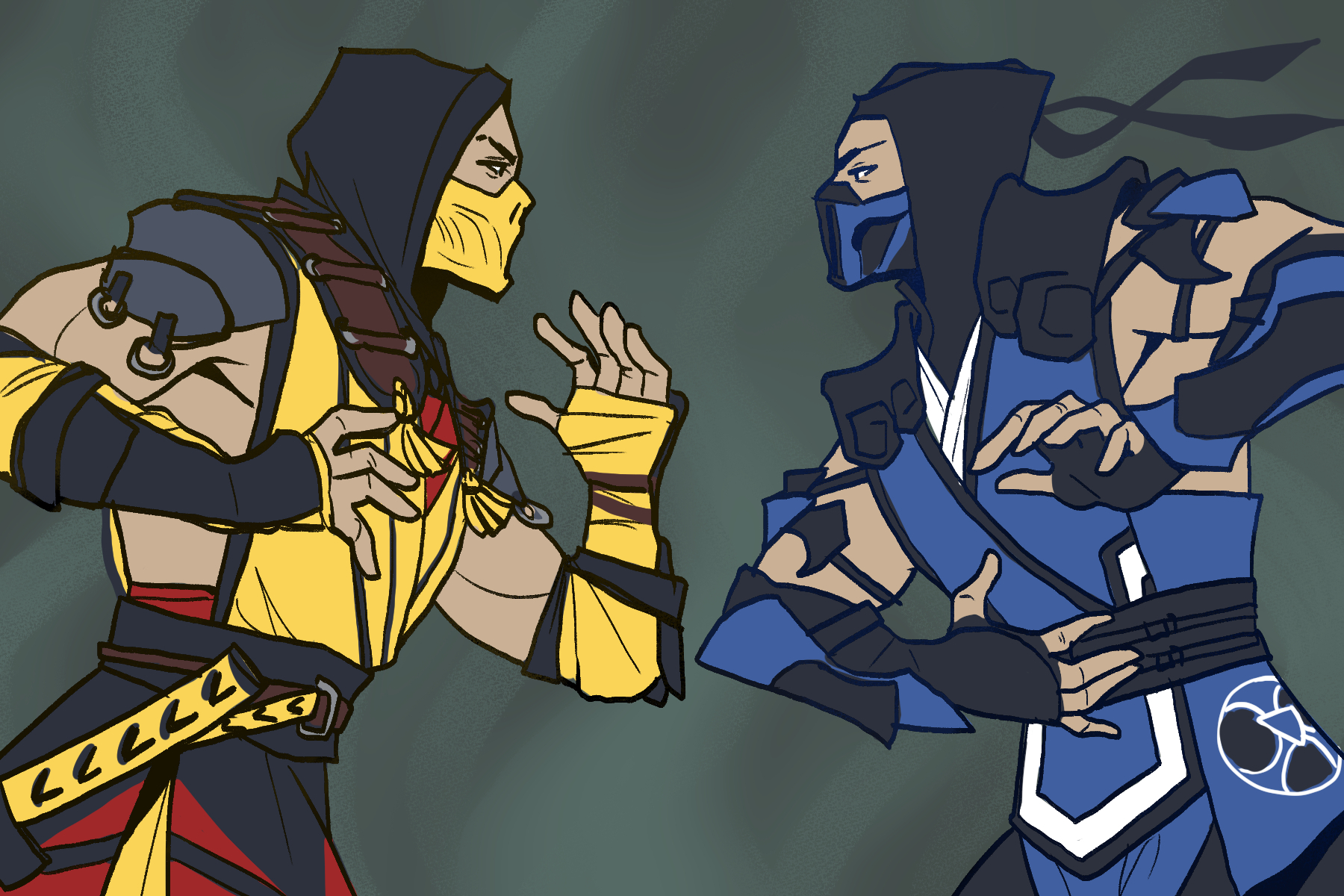Since their inception, fighting games have been one of the most iconic genres in the gaming industry. Franchises like Street Fighter, Mortal Kombat and Super Smash Bros. are instantly recognizable to most people, including those who are unfamiliar with the genre. Despite their long-standing status as a staple of gaming, however, fighting games haven’t always maintained the same level of success. The journey from their earliest entries to the critically acclaimed classics of today wasn’t without its fair share of troubles. However, understanding how fighting games overcame their greatest obstacles and made a surprise resurgence can help developers of other struggling genres.
Arcade Origins of Fighting Games
Like most gaming genres, fighting games first appeared on arcade cabinets. Although the genre technically began in the ’70s and ’80s with simplistic titles like Heavyweight Champ, Karate Champ and the original Street Fighter, the modern fighting game formula wasn’t established until 1991 with the releases of Street Fighter II: The World Warrior and Fatal Fury: King of Fighters. Unlike their predecessors that restricted the player to a single character, these games offered diverse rosters of playable fighters who each possessed a distinct fighting style. Combined with their impressive visuals and the ability to compete against other players, both games demonstrated the mechanically complex and endlessly varied potential of fighting games.
Over the next few years, developers constantly strived to refine and perfect the fighting game formula while introducing new innovations to the genre. Alongside the release of new installments in the Fatal Fury and Street Fighter franchises, 1992 saw the blood and gore-filled Mortal Kombat enter arcades. The game’s excessive violence and use of digitized actors for its playable characters formed a mature spectacle that was rare in video games of the era. The growing improvements in video game technology also allowed titles like Virtua Fighter and Tekken to introduce 3D fighters in 1993 and 1994, respectively. Regardless of style or presentation, fighting games continued to thrive thanks to developers like Capcom, SNK and Namco. These and many other developers continued to release countless fighting game classics throughout the ’90s, with each successive year producing games with increasingly better visuals and more refined gameplay. Unfortunately, as the decade approached its end, the genre faced a new challenge.
Struggles in the Console Landscape
The rise of home consoles during the ’80s and early ’90s initially did little to affect the success of fighting games in arcades. Most early console ports and exclusives failed to match the quality of their arcade equivalents, usually due to worse graphics, faulty controls or significant censorship. However, this changed with the arrival of consoles like the PlayStation and the Dreamcast, which allowed for fighting games to include just as much (if not more) content than their original arcade releases. Although arcades continued to thrive in Japan (where many fighting game developers were located), their popularity in Western countries was dwindling by the end of the ’90s.
As consumers moved away from arcades and toward consoles, developers followed and began to design new fighting games with these home platforms in mind. Some games used the consoles’ ability to host four players at once to create new sub-genres of fighting games, such as platform-fighters like Super Smash Bros. Titles with more traditional gameplay added new modes to flesh out their story and characters, or simply provide a fun distraction from the standard gameplay. Despite developers’ efforts to appeal to the console market, the complexity and depth of fighting games made them one of the least accessible genres on consoles, warding off many casual players.
Fortunately, the hardcore fans that stuck around formed competitive tournaments, which served as the new lifeblood of the genre. While these started as small gatherings held for fun, many later tournaments offered cash prizes to attract skilled participants and increase attendance. These public events may not have been as commonplace as arcades in the ’90s, but they revived and heightened the competitiveness that fighting games once produced in arcades. Fighting games no longer held the same mainstream appeal as their early entries, but this enthusiastic fanbase ensured that the genre would remain an active part of the gaming industry.
Fighting games received another chance to return to their former status with the start of the seventh console generation. While online play also existed on older hardware, it practically defined the Xbox 360 and PlayStation 3 era. Being able to compete against thousands of other players around the world from the comfort of your own home was a concept that appealed to experienced and casual players alike. As such, online gaming seemed like the perfect opportunity for developers to revive the mainstream popularity of fighting games.
Unfortunately, multiple factors led the seventh console generation to become one of the lowest points in the history of fighting games. The online functionality in these contemporary titles was incredibly unreliable, resulting in horrendous lag and connection issues that rendered most online matches nearly unplayable. Additionally, the reliance on paid downloadable content meant many games launched with far fewer features and playable characters than their predecessors. Worst of all, the genre struggled to find ways to attract new fans. Most games lacked guidance for inexperienced players, and the few that appealed to casual players oversimplified their gameplay, driving away many long-time fans in the process.
This isn’t to say that the seventh generation was entirely disastrous for fighting games. Excellent sequels such as Mortal Kombat (2011) and The King of Fighters XIII represented some of the best entries in their respective series. Original franchises like BlazBlue and Skullgirls proved the genre was still capable of delivering new and creative ideas. Even with these successes, the fighting game genre fumbled its chance to draw in new fans, and the growing prominence of greedy business practices from its developers began to test the patience of even its most die-hard fans.
An Unexpected Revival
After years of gradual decline, the next generation of consoles provided a chance for fighting games to redeem themselves. However, this change wouldn’t arrive immediately, as highly anticipated titles like Street Fighter V, The King of Fighters XIV and Marvel vs Capcom: Infinite struggled at release due to mixed critical reception and rushed developments. Well-received games like Killer Instinct (2013) and Guilty Gear Xrd Revelator were met with moderate success, but most failed to find a mainstream audience except for Super Smash Bros. for Wii U and Mortal Kombat X.
This finally changed in 2017, when Tekken 7 and Injustice 2 garnered massive attention and acclaim from fighting game fans and newcomers. Both titles made drastic improvements to their series’ formula by improving existing mechanics while also adding new features to excite series veterans. The latter game is especially notable for its online functionality, which rarely suffers from the lag and performance issues that plague many other titles. Together, these two games proved that developers were finally listening to fan feedback. In doing so, they amassed plenty of new fans who eagerly waited to see if the fighting game genre could retain its newfound popularity.
Even against massive expectations, 2018 surpassed them with an influx of excellent new titles, with some of the most notable examples being Soul Calibur VI, Dragonball FighterZ and Super Smash Bros. Ultimate. Further, more developers began to move away from the practice of forcing players to buy updates to preexisting games. Instead, newer games are supported through free updates and low-priced downloadable content. Aside from being easier on consumers’ wallets, this change demonstrates how developers are now focusing on supporting one title for multiple years rather than constantly charging for new releases and sequels. Such moves make each fighting game seem like a worthwhile investment. Not every game uses this practice wisely (Dead or Alive 6 is an infamously greedy example), but the increasing prevalence of this cheaper approach is a good sign for the genre’s future.
The genre’s surprising resurgence was aided by multiple other changes to its formula. One of these is the new way developers design online functionality in fighting games. Most titles structure their online modes around a system known as delay-based net code. According to an article by Ricky Pusch, this system creates a brief delay between the moment the player inputs a command from their controller and the time the corresponding action occurs on screen. In theory, this should provide time for the game to register the actions of the other player, thus showing the same thing on both sides of the network at once. Unfortunately, this system relies on players having consistent network speeds, which is almost never the case. As a result, delay-based net code usually causes online matches to suffer from severe slowdowns and extensive pauses during gameplay. Despite the flaws of delay-based net code, many modern games still use it due to its simplicity and ease of implementation.
To avoid the issues common in online fighting games, some titles like Injustice 2 have adopted a more complex system known as rollback net code, wherein the game displays a prediction of the other player’s next actions and placement based on the last registered input. Rather than waiting to receive inputs, the game constantly updates its display based on new information, allowing for online matches that rarely suffer from interruptions. This system also has its flaws, but it provides a much more enjoyable online experience and can even be combined with delay-based systems for a near-flawless performance. While some developers still refuse to use rollback net code, its increasing prevalence is another example of how fighting game developers are finally listening to and resolving the genre’s biggest criticisms.
Possibly the most important change in modern fighting games is their revamped approach to accessibility. Rather than reducing the complexity and depth of gameplay to appeal to casual players, recent titles attempt to help new players understand their in-depth mechanics through various methods. Games like Skullgirls provide extensive yet easily understandable tutorials that explain both the game’s mechanics as well as important terminology used by fighting game experts. Similarly, Street Fighter V and Tekken 7 provide both traditional and simplified control schemes, as well as offer single-button shortcuts to help players perform attacks that require difficult inputs. Ultimately, these additions prove that accessibility isn’t about simplifying the game, but instead finding ways to ease new players into the genre’s entertaining complexity.
However, one of the greatest contributors to the genre’s revival doesn’t involve its games, but rather its community. The increased use of social media and streaming websites provides more ways than ever for newcomers to learn about fighting games. Online guides and forums answer questions and deliver helpful information about specific games. Additionally, the growing popularity of YouTube channels centered around fighting games offers even more information through gameplay footage, commentaries and tutorials. Finally, esports has reached mainstream exposure, making it easy to watch fighting game tournaments like the Evolution Championship Series (EVO) on ESPN and Twitch. As such, it has never been easier for newcomers to consult and get involved in the fighting game community.
Even now, the fighting game genre continues to surprise fans with amazing new titles such as the recently released Guilty Gear Strive and King of Fighters XV, while building excitement for upcoming releases like Street Fighter 6. As such, it’s safe to say that the fighting game genre has finally restored its reputation thanks to the recent releases of some of the best games in its entire history. There’s still plenty of room for improvement, as few fighting games provide accommodations for players with hearing or visual disabilities, and many publishers still refuse to invest in rollback net code. Regardless of these issues, the genre’s ability to overcome its past mistakes has led to a fantastic mainstream resurgence.

















